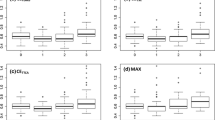Abstract
Objective: The objective of this study was to investigate the effect of occupational exposure to carbon disulfide (CS2) concentrations below threshold limit value (TLV)-time-weighted average (TWA) (31 mg/m3) on total cholesterol, blood pressure and the prevalence of coronary heart disease (CHD). Methods: A cross-sectional study involving 141 viscose rayon workers (64 men), and 141 age- and gender-matched controls without occupational contact with noxious chemicals, was carried out. The probability for CHD was determined by means of the WHO questionnaire and was 12-lead electrocardiography-coded using Minnesota criteria. Blood pressure was measured by the standardized method of the WHO and blood was examined for total cholesterol. A cumulative exposure index (CS2 index) was calculated for each worker by multiplying the number of years held in a particular job, by the CS2 concentrations in that job-environment. According to the CS2 index, the exposed workers were distributed into two groups: group 1 (CS2 index <100) and group 2 (CS2 index ≥100). Results: Depending on the job and specific work place the CS2 concentrations were between 1 and 30 mg/m3. Cholesterol levels were significantly higher in the exposed group (4.9 ± 0.7) compared with the controls (4.6 ± 0.7). Adjustment for age, smoking, body-mass index (BMI) and gender showed the significant effect of the CS2 index on the total cholesterol (P < 0.001). The prevalence of hypercholesterolaemia was significantly higher in the exposed group (42.6%), compared with the controls (26.2%); odds ratio (OR) (adjusted for potential confounders) was 2.56, 95% CI 1.47–4.46. Logistic regression showed a significantly increased risk for elevated cholesterol in group 2 (OR 5.52; 95% CI 2.81–10.83). No significant effect of CS2 index on blood pressure and CHD prevalence was found. Conclusions: The results of our study show that occupational exposure to CS2 concentrations below 31 mg/m3 and a CS2 index >100 may increase total cholesterol. Our results imply that even the CS2 concentrations below TLV-TWA may produce morbid changes, and suggest the mechanism of the effect of CS2, leading to lipid metabolism disturbances and acceleration of atherosclerosis.
Similar content being viewed by others
Author information
Authors and Affiliations
Additional information
Received: 1 February 2000 / Accepted: 24 June 2000
Rights and permissions
About this article
Cite this article
Kotseva, K. Occupational exposure to low concentrations of carbon disulfide as a risk factor for hypercholesterolaemia. Int Arch Occup Environ Health 74, 38–42 (2000). https://doi.org/10.1007/s004200000186
Issue Date:
DOI: https://doi.org/10.1007/s004200000186



